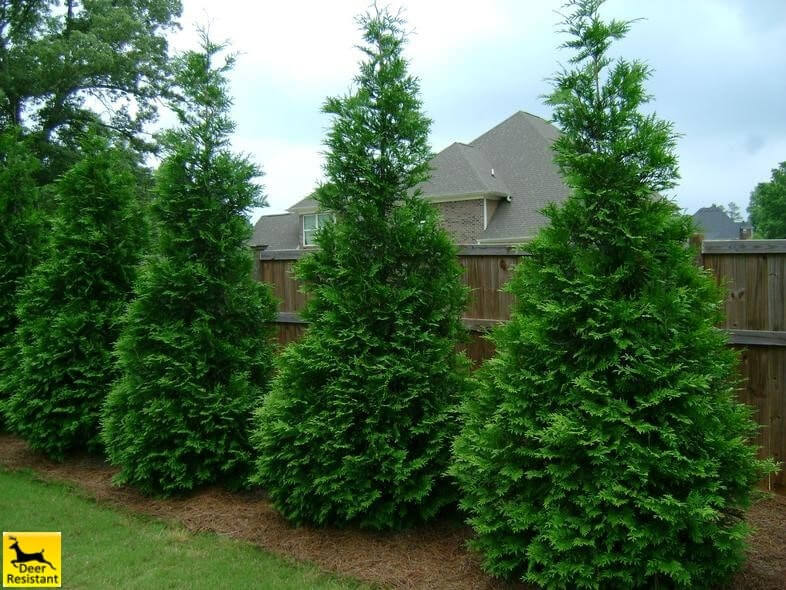
Caring for Thuja Trees: Keep Your Evergreens Vibrant Year-Round
Share
Thuja trees, also known as arborvitae, are a popular choice for home gardeners thanks to their attractive evergreen foliage and low-maintenance nature. These versatile conifers come in various shapes and sizes, offering something for every landscaping need. Whether you're seeking a towering privacy screen or a compact accent plant, there's a Thuja variety out there perfectly suited for your vision.
But even though Thuja trees are known for their resilience, caring for them properly will ensure they thrive and bring life to your landscape year-round.
In this comprehensive guide, we'll discuss everything you need to know about caring for Thuja trees, from planting and watering to pruning and pest control.
So, without further ado, let's get started:
Planting the Perfect Spot for Your Thuja
Thuja trees prefer well-drained soil with a slightly acidic to neutral pH level (between 6.0 and 7.0). If your soil is heavy clay, amending it with sand or compost before planting can improve drainage. They're adaptable to sun and partial shade, although full sun exposure will encourage the most vibrant foliage growth.
Consider the mature size of your chosen Thuja variety when selecting a planting location. Some Thuja giants, like the Green Giant, can reach upwards of 30 feet tall, so ensure they have ample room to grow without crowding structures or power lines.
Let's get planting! Here's a step-by-step guide:
- Take the tree out of its container and carefully shake off any roots that are circling.
- After the tree has been planted, level the root ball with the surrounding dirt.
- Fill in the hole again with the adjusted soil, gently pressing it down to eliminate any air pockets.
- To help the soil around the roots settle, give the tree a lot of water.
- To keep the organic mulch from rotting, spread a 2-to 3-inch layer around the tree’s base, keeping it a few inches away from the trunk.
Pro Tip: Water freshly planted Thuja trees often until they get established, especially in hot and dry weather (typically after the primary growing cycle).

Watering Your Thuja Trees
Established Thuja trees are surprisingly drought-tolerant, but consistent moisture is crucial for optimal health and growth. Here's a breakdown of watering needs based on the season:
- Spring and Summer: Water your Thuja trees deeply once a week, allowing the soil to dry slightly between waterings. Aim to soak the root zone, encouraging deep root development.
- Fall and Winter: As temperatures cool and rainfall increases, you can reduce the watering frequency. Water only when the top few inches of soil feel dry to the touch.
Signs Your Thuja Needs Water
- Wilting or drooping foliage
- Dry, brittle needles
- Off-colored leaves (yellowing or browning)
Pro Tip: A good watering practice is to use a slow trickle hose or soaker hose at the tree's base for an hour or so, allowing the water to penetrate deeply.
Pruning for Shape and Health
Thuja trees are naturally slow-growing and generally require minimal pruning to maintain their shape. However, strategic pruning can be beneficial for several reasons:
- Maintaining Shape and Size:If you desire a specific shape or want to keep your Thuja tree from exceeding its allotted space, you do light pruning in late spring or early summer.
- Encouraging Growth:Removing dead, diseased, or damaged branches promotes better air circulation within the tree and allows sunlight to reach inner branches, stimulating new growth.
- Enhancing Privacy:For privacy hedges, shearing the sides of the Thuja trees regularly throughout the growing season will help maintain a dense, uniform appearance.
Pruning Tips
- Always use sharp, sterilized pruning shears or loppers to avoid ragged cuts and potential disease transmission.
- When pruning for shape, focus on removing no more than one-third of the new growth per year.
- Avoid pruning into old wood, as Thuja trees generally don't sprout new growth from bare branches.
For more extensive pruning or if you're unsure about proper techniques, consider consulting a certified arborist.
Fertilizing for Optimal Growth
While Thuja trees are generally not heavy feeders, a balanced fertilizer can help them grow, especially in less-than-ideal soil conditions. Here are some things to keep in mind:
- Timing:Apply fertilizer in early spring, just before new growth emerges. You can also give them a light feeding in late fall, but avoid fertilizing during the hot summer months.
- Type:Opt for a slow-release, balanced fertilizer formulated for evergreen trees. Follow the application instructions on the product label carefully, as overfertilizing can damage your Thuja.
- Organic Options:If you prefer a more natural approach, consider using composted manure or composted leaves as a mulch around the base of your Thuja trees. These organic materials will decompose slowly, releasing nutrients into the soil over time.
Choosing the Right Thuja for Your Needs
With multiple Thuja cultivars available, each offering unique characteristics, selecting the perfect one for your landscape can feel overwhelming. Here's a quick guide to some popular Thuja varieties:
- Thuja Green Giant: This fast-growing giant is ideal for creating privacy screens and windbreaks.
- American Pillar Arborvitae: Known for its columnar shape and dense foliage, this variety makes an excellent choice for foundation plantings and narrow spaces.
- Gentle Giant Arborvitae: The Gentle Giant Arborvitae is a smaller privacy tree that has most all features of Thuja Green Giant.
Ready to Shop Thuja Trees?
Thuja Gardens offers a wide selection of high-quality Thuja trees, including Thuja Green Giant, American Pillar Arborvitae, Gentle Giant arborvitae, and many more. Browse our extensive collection to find the perfect Thuja variety to enhance your landscape. We also offer Thuja seedlings arborvitae, ideal for those seeking a smaller, slower-growing option.
Whether you're looking for a Dwarf- like tree, The Gentle Giant, or towering Thuja Green Giant arborvitae, Thuja Gardens has something for everyone. Visit our website today to Shop Thuja trees online and experience the beauty and benefits of these versatile evergreens!
